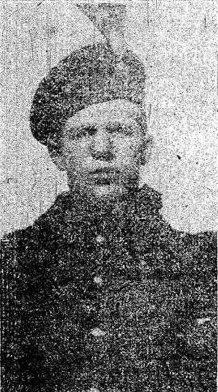Pte
John Stephen Bowran
Information about birth
|
Date of birth: 28/10/1897 |
|
Place of birth: Westville, Pictou County, Nova Scotia, Canada |
General information
|
Last known residence: Stellarton, Pictou County, Nova Scotia, Canada |
|
Profession: Miner |
|
Religion: Presbyterian |
Army information
|
Country: Canada |
|
Force: Canadian Expeditionary Force |
|
Rank: Private |
|
Service number: 222170 |
|
Enlistment date: 08/10/1915 |
|
Enlistment place: Halifax, Nova Scotia, Canada |
|
Units: — Canadian Infantry, 85th Bn. (Nova Scotia Highlanders) (Last known unit) |
Information about death
|
Date of death: 30/10/1917 |
|
Place of death: Vienna Cottages - Stein Hof, Passchendaele, Belgium |
|
Cause of death: Killed in action (K.I.A.) |
|
Age: 20 |
Cemetery
|
Tyne Cot Cemetery Plot: XXXVI Row: E Grave: 23 |
Distinctions and medals 2
|
British War Medal Medal |
|
Victory Medal Medal |
Points of interest 4
| #1 | Place of birth | ||
| #2 | Last known residence | ||
| #3 | Enlistment place | ||
| #4 | Place of death (approximate) |
My story
John Stephen Bowran was born on October 28, 1897, in Pictou County, Nova Scotia, Canada. On October 8, 1915, the young miner enlisted in the Canadian Expeditionary Force in Halifax. He was eventually assigned to the 85th Battalion, better known as the Nova Scotia Highlanders, part of the 12th Canadian Brigade of the 4th Canadian Division.
On October 28 — John’s 20th birthday — the 4th Canadian Division left camp near Ypres. They moved to Seine Corner at the front, where they relieved the 44th Battalion at Keerselaere, between Tyne Cot and Passchendaele. The men spent October 29 in shell craters and narrow trenches, preparing for the next day’s attack.
On October 30, 1917, the Canadians resumed their assault on Passchendaele. The 85th Battalion (Nova Scotia Highlanders) followed the Ypres–Roulers railway line toward Vienna Cottages — once a cluster of homes nestled by the railway. The hamlet had been reduced to a chain of shell holes. The Nova Scotia Highlanders faced intense resistance. The guns covering the attack had sunk into the mud and could barely offer support. As soon as the Highlanders freed themselves from the mire, they came under heavy fire. But the storm surged forward, unstoppable. In exchange for the reeking pits at Vienna Cottages, half of the Highlanders were killed, wounded, or missing. Before returning to Canada, the 85th Battalion placed a memorial near what had been their approximate jumping-off point.
John, barely 20 years old, was killed on October 30, 1917, near the railway and Vienna Cottages, where he received a field burial. According to his entry in the Canada, War Graves Registers (Circumstances of Casualty), he was struck in the head by machine-gun fire while serving as a stretcher-bearer. After the war, he was reburied at Tyne Cot Cemetery, Plot XXXVI, Row E, Grave 23.
On October 28 — John’s 20th birthday — the 4th Canadian Division left camp near Ypres. They moved to Seine Corner at the front, where they relieved the 44th Battalion at Keerselaere, between Tyne Cot and Passchendaele. The men spent October 29 in shell craters and narrow trenches, preparing for the next day’s attack.
On October 30, 1917, the Canadians resumed their assault on Passchendaele. The 85th Battalion (Nova Scotia Highlanders) followed the Ypres–Roulers railway line toward Vienna Cottages — once a cluster of homes nestled by the railway. The hamlet had been reduced to a chain of shell holes. The Nova Scotia Highlanders faced intense resistance. The guns covering the attack had sunk into the mud and could barely offer support. As soon as the Highlanders freed themselves from the mire, they came under heavy fire. But the storm surged forward, unstoppable. In exchange for the reeking pits at Vienna Cottages, half of the Highlanders were killed, wounded, or missing. Before returning to Canada, the 85th Battalion placed a memorial near what had been their approximate jumping-off point.
John, barely 20 years old, was killed on October 30, 1917, near the railway and Vienna Cottages, where he received a field burial. According to his entry in the Canada, War Graves Registers (Circumstances of Casualty), he was struck in the head by machine-gun fire while serving as a stretcher-bearer. After the war, he was reburied at Tyne Cot Cemetery, Plot XXXVI, Row E, Grave 23.
Sources 5
|
Hayes J., The Eighty-Fifth in France and Flanders, (Halifax, Royal Print & Litho Limited, 1922), 90-96. Sources used |
|
McCarthy Chris., Passchendaele. The Day-by-Day Account (London, Unicorn Publishing Group, 2018) 153. Sources used |
|
Personnel Records of the First World War (Library and Archives Canada, Ottawa (LAC), RG 150, Accession 1992-93/166, Box 964 - 28). https://library-archives.canada.ca/ Sources used |
|
War diaries: 85st Canadian Infantry Battalion (Library and Archives Canada, Ottawa (LAC), RG9-III-D-3, Volume number: 4944, Microfilm reel number: T-10751--T-10752, File number: 454). https://library-archives.canada.ca/ Sources used |
|
War Graves Registers: Circumstances of Death (Library and Archives Canada, Ottawa (LAC), RG 150, 1992-93/314; Volume Number: 156). https://library-archives.canada.ca/ Sources used |
More information 4
|
Commonwealth War Graves Commission Database https://www.cwgc.org/find-records/find-war-dead/casualty-details/462011 |
|
Namenlijst (In Flanders Fields Museum) https://namenlijst.org/publicsearch/#/person/_id=972aba94-bea1-4fc5-a183-d3d291b488cc |
|
The Canadian Virtual War Memorial https://www.veterans.gc.ca/eng/remembrance/memorials/canadian-virtual-war-memorial/detail/462011 |
|
Lives of the First World War (Imperial War Museum) https://livesofthefirstworldwar.iwm.org.uk/lifestory/5592201 |
